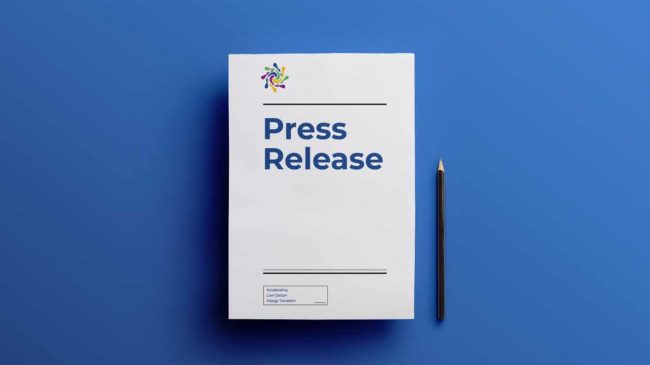Jakarta, February 2, 2024 – Indonesia, under the coordination of the Ministry of Environment and Forestry (MoEF), has initiated the drafting process for its Second National Determined Contribution (SNDC) aimed at emissions reductions by 2030 and 2035. The MoEF intends to submit the SNDC to the UNFCCC in 2024.
The Institute for Essential Services Reform (IESR) along with several civil society organizations have requested for revisions in the SNDC, proposing updated scenarios and targets aligned with the objective of limiting global warming to below 2 degrees Celsius. They advocate for striving to achieve the ambitious goal of 1.5 degrees Celsius, as set forth by the Paris Agreement and reinforced by the Global Stocktake decision at COP 28.
IESR also urges the government to engage public participation in the preparation process of the SNDC. Furthermore, it is essential for the government to adhere to the principles outlined in Article 4, Line 13 of the Paris Agreement and the provisions of the COP series during SNDC preparation.
Currently, the government continues to utilize the business-as-usual (BAU) scenario for calculating emission reductions. However, civil society deems this scenario irrelevant as a basis for emission calculations. Indonesia must transition to a more accurate calculation system that references relative emissions in a given year, considering a realistic trajectory of global and Indonesian economic growth.
“While the emission reduction target in the Enhanced NDC (ENDC) appears to be increasing, it still does not align with the goal of limiting temperature rise to 1.5 degrees Celsius. Presently, the ENDC target only aims for a 31-43 percent reduction below BAU. If using the BAU calculation method employed thus far for setting emission reduction targets in the NDC, Indonesia’s target should be at least a 60 percent reduction from BAU for unconditional efforts and a 62 percent reduction from BAU for conditional efforts with international assistance. These figures do not include emission reductions from the agriculture, forestry, and land sectors,” remarked IESR Executive Director Fabby Tumiwa.
According to the analysis conducted by IESR, using 2022 emissions as the benchmark for target setting, Indonesia must establish an unconditional emissions reduction goal of 26 percent, equivalent to 859 MtCO2e by 2030, and a conditional reduction target of 28 percent, amounting to 829 MtCO2e with international assistance. These targets are crucial for contributing to the objective of limiting temperature rise to 1.5 degrees Celsius.
In addition to increasing emission reduction targets, Indonesia must also diminish the reliance on fossil energy sources such as coal and gas within its energy system. Based on calculations from the Climate Action Tracker (CAT), the coal component in Indonesia’s electricity system should be reduced to 7 to 16 percent by 2030, with the phasing-out of PLTU operations before 2040. Similarly, gas usage needs to be curtailed to 8 to 10 percent by 2030, with phasing-out operations by 2050.
Deon Arinaldo, IESR’s Energy Transformation Program Manager, emphasized that the reduction in the fossil energy mix should be accompanied by an increase in the share of renewable energy, ranging from 55 to 82 percent by 2030. However, it is worth noting that the target listed in the ENDC pertains to the installed capacity of renewable energy rather than the actual mix. IESR contends that solely focusing on installed capacity does not adequately reflect the relationship with emission reduction objectives.
“With the clarity of the renewable energy mix target in the electricity sector, it becomes possible to anticipate and even calculate the emission intensity of the electricity sector by 2030 to achieve the SDNC target. Furthermore, a significant presence of renewable energy will offer a clearer roadmap for electricity planning, specifying the types of renewable energy that should be prioritized to bridge the existing gap. With only 7 years remaining, it’s evident that solar and wind power plants, known for their shorter construction periods, should take precedence in development efforts to meet the mix target. Additionally, interventions are necessary for fossil fuel power plants, emphasizing the importance of reducing the reliance on fossil energy through various strategies such as terminating the operation of PLTU or reducing its utilization,” stated Deon.
Furthermore, IESR and other civil society organizations criticize the ENDC document for neglecting to incorporate the principle of climate justice. Civil society advocates for the SNDC preparation process to be more inclusive, ensuring climate protection for vulnerable groups and transparency throughout.
Wira Swadana, IESR Green Economy Program Manager, emphasized that the government must ensure fair distribution of the burden of emission reduction.
“Entities responsible for the highest emissions must shoulder a larger portion of the emission reduction efforts. Furthermore, the formulation of the SNDC should prioritize the principle of climate justice, which aims to mitigate both short-term and long-term risks while ensuring fair distribution of benefits, burdens, and risks, particularly for marginalized communities,” remarked Wira.
IESR and other civil society groups have outlined six recommendations for the preparation of the SNDC. First, the government should adhere to the principles of the Paris Agreement as outlined in Article 4, Line 13, and the guidelines set forth by the COP. Second, there should be a focus on integrating measurement, reporting, and verification (MRV) systems tailored for developing country parties. Third, the government should abandon the use of the BAU scenario as the basis for emission reduction calculations and instead adopt a method based on relative emissions in a given year, which takes into account more precise global and Indonesian economic growth projections. Fourth, climate targets should be established in alignment with the Paris Agreement. Fifth, there should be transparent and publicly accessible monitoring and evaluation mechanisms put in place. Sixth, principles of climate justice should be incorporated and implemented throughout the process. These recommendations for the preparation of the Second NDC have been submitted to relevant ministries and institutions.

